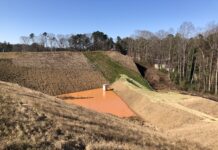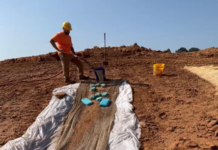
If a construction site is “out of control” from an erosion and sediment control standpoint, those in charge should review the Five Pillars of Construction Stormwater Management [see “Five Pillars,” page 15]. These pillars — manage communication, work, water, erosion and sediment — are now widely distributed throughout the construction stormwater management world and are easily found with an internet search. Let’s assume that you can get the first three pillars — communication, work and water — fixed and you are ready to conquer the fourth pillar, erosion.
In order to control erosion on a construction site, you must first understand the erosion process.
Rainfall and the surface runoff of rainfall produces four main types of erosion on a construction site:
- Splash erosion occurs when the raindrop impacts the bare soil surface and dislodges soil particles (Figure 1).
- Sheet erosion occurs either after the surface of the soil is saturated or the rainfall exceeds the infiltration rate of the soil. Then the soil detached by splash erosion and the additional soil particles detached by runoff/overland flow move downslope. Splash and sheet erosion are sometimes referred to as interrill erosion.
- Rill erosion occurs when the sheet flow concentrates and causes small rills with a depth of about 1 inch (2.5-cm), further eroding the soil surface.
- Gully erosion occurs when runoff water in a rill detaches more soil and deepens and/or widens the channel to a significant size. There is no universally recognized depth when a rill becomes a gully.
So, if we can control erosion, there is much less sediment to deal with on a construction site. And the best way to control erosion is to stop the processes of splash and sheet (interrill) erosion.
In order to do this, we should always look for ways to:
- Minimize the amount of bare soil exposed to the environment by phasing work and limiting vegetation clearing.
- Minimize the time that bare soil is exposed to the environment by covering the surface of the bare soil and vegetating each are as soon as the final surface is achieved.
When you minimize erosion, capturing sediment, also known as the fifth pillar, becomes easier.

Establishing Vegetation
If areas are already bare, how can you establish vegetation to control erosion? In order to establish permanent vegetation and ensure that it is long-lived, the root zone in the soil must be “right.” That is, the pH must be within an acceptable range, and the plant community must have access to the plant nutrients needed for a particular species to thrive.
So, what if your soil test calls for agricultural lime and plant nutrients, such as nitrogen, phosphorus and potassium fertilizer? How do you ensure these soil amendments are incorporated the best way for the roots?
Whenever possible (generally slopes 3:1 or flatter), lime and fertilizer should each be applied in split applications crossing each other to ensure uniformity. Once applied, the soil amendments should be incorporated through heavy discing or rototilling (Figure 2) to the depth needed to create an adequate zone for root development, which is generally 6 to 8 inches (15 to 20 cm). Incorporation of lime increases pH at a much faster rate in the root zone than surface-spread lime with no incorporation. I’m told that surface-applied lime slowly moves down into the soil at a rate of only one-fourth inch per year.
So, whenever possible incorporate your lime and fertilizer, and the vegetation will thank you by being there for years.
Once the sodding or seeding and mulching are properly completed, the area needs moisture for the seed or plants to thrive and cover the area. Your site could be getting into the time of year when soils can be dry due to hot and/or windy conditions, and you can have several days without rain. So, to encourage germination of seed and growth of grass or sod, we turn to irrigation to overcome dry soil and drought conditions. The question then is “how much water is needed?” And the answer is probably more than you thought.
Newly seeded areas need water for germination and then water for growth. Newly sodded areas need immediate water for sod survival, and then frequent watering until the sod has formed a good root system. Follow quality guidance documents from sources such as extension services to determine how much water is needed. One inch of water would probably be a minimum for initial watering. That equates to about 27,154 gallons of water for an acre (254,000 liters per hectare). Can you do that with a hydroseeder? Maybe, but it would take a large tank hydroseeder multiple loads for an acre or hectare. After the initial wetting, newly seeded and sodded areas will need additional water daily or maybe multiple times per day until germination or root development. The other issue is that the water needs to infiltrate and not run off. So, it would need to be gradually and evenly applied, which is hard to do with a hydroseeder. To do it right means using a properly designed irrigation system.
You can use a hydroseeder to apply water on small areas, but if large areas need water, plan for an irrigation system. As the spring and summer days pass by, it becomes increasingly important to care for the seeding or sodding project as growing days become fewer to establish the desired vegetative cover.
If you minimize erosion in every way possible, sediment control is much easier.
The bottom line is “Keep the Soil Covered.”
About the Expert
Perry L. Oakes, PE is currently Alabama’s Erosion and Sediment Control Program Coordinator for the Alabama Soil and Water Conservation Committee. Perry was formerly the State Conservation Engineer for USDA-Natural Resources Conservation Service in Alabama.
Five Pillars Provides Erosion and Sediment Control Framework for Construction Sites
The Alabama Department of Transportation pioneered an innovative approach to better management of erosion and sediment on large construction sites. The approach focuses on identification and implementation of effective best management practices that make practical and economic sense for the project versus simply checking items off a compliance checklist. The Five Pillars of Construction Stormwater Management are to be implemented in order of effectiveness and economy. They include the following actions, in order:
- Manage communication.
- Manage work.
- Manage water.
- Manage erosion.
- Manage sediment.
Reference
Fagan B. The Five Pillars of Construction Stormwater Management. TR News No.328 July-August 2020, pp. 38-41. https://onlinepubs.trb.org/onlinepubs/trnews/trnews328Pillars.pdf.












